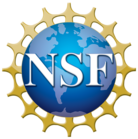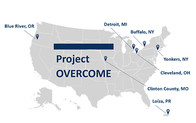|
COMPUTER & INFORMATION
SCIENCE AND ENGINEERING |
|
|
A Message from CISE Leadership
Dear colleagues.
We are pleased to share our May newsletter, which has two main themes. First, May marks the 35th birthday of the CISE Directorate, and this newsletter begins with some highlights from our investments over the years. Second, we also offer a few key programmatic updates, including the launch of a new program and the continuation of a COVID-19-related initiative that started a year ago.
CISE’s 35th birthday. Since its inception, CISE has provided valuable contributions to research and education. Founded on May 1, 1986, CISE played a critical role in nurturing information technology, in an era when information technology became a pillar across domain-specific research, education, and commercial and social practices.
One of CISE’s key early investments in information technology was the Digital Libraries Initiative (DLI). This initiative provided global, multilingual repositories of data, knowledge, sound, and images. Through the DLI, NSF supported a project that would ultimately result in the creation of Google.
You can read more about our initiatives—past and present—in the SciComm Corner section below. Please also share with us your CISE research highlights and memories by e-mailing us at, cisehighlights@nsf.gov.
Resilient and Intelligent Next-Generation Systems (RINGS). Last month, CISE was pleased to launch its newest public-private partnership. The RINGS program is a partnership between NSF, two other federal agencies (the National Institute of Standards and Technology, and the US Department of Defense’s Office of the Undersecretary of Defense for Research and Engineering), and nine industry partners (Apple, Ericsson, Google, IBM, Intel, Microsoft, Nokia, Qualcomm, and VMware). This new program seeks to accelerate research in areas with potentially significant impact on Next-Generation (NextG) networking and computing systems. See the Program Spotlight below for more details, including how to submit proposals by the program deadline.
Computing Innovation Fellows (CIFellows) 2021. One year ago, CISE funded the Computing Innovation Fellows (CIFellows) Project to provide emergency post-doctoral funding to 59 individuals for up to 2 years. This project enables a career-enhancing bridge for recent and soon-to-be Ph.D. graduates in computer and information science and engineering whose job search was hampered by the pandemic. Recognizing the ongoing challenges of the pandemic and its impact on our workforce, CISE, together with the Computing Research Association and its Computing Community Consortium, launched a 2021 version of the CIFellows Project. We invite applications for a second cohort of up to 70 CIFellows. Please share this information broadly and encourage researchers to apply before the May 17 deadline.
CloudBank. Finally, as faculty hiring season approaches, we would like to note the availability of the NSF-funded CloudBank resource, which provides the research community with access to commercial cloud computing offerings for research and education. CloudBank can be used by department chairs to allocate computer resources for startup packages for newly hired faculty.
As CISE looks ahead to its next 35 years, democratizing access to research, education, and infrastructure is a key part of our mission.
 Margaret Martonosi
NSF Assistant Director for CISE
Joydip Kundu
Acting Deputy Assistant Director for CISE
 Erwin Gianchandani
Senior Advisor, Office of the Director
|
|

These future networks and systems will provide key support to societal priorities such as education, transportation, public health and safety, defense and associated critical infrastructure.
|

By focusing on crop stressors at the individual levels, farmers can focus their resources and attention, thus reducing the cost of labor and the use of crop inputs such as pesticides, fertilizer, and water.
|

NSF stands ready to maximize the impact of this increase in funding and tackle critical challenges to bolster the U.S. economy and our leadership in critical and emerging areas of research and technological advancements.
|

A natural brilliant blue food coloring has been discovered by an international team of researchers including chemists at the University of California, Davis.
|

AI systems might reach higher performance if programmed with human language.
|

The effort will support seven community deployments meant to uncover strategies to connect underserved populations in ways that can be extended and replicated across the country.
|
Get more CISE News
|
|
Resilient & Intelligent NextG Systems (RINGS) Program
CISE is excited to share the Resilient & Intelligent NextG Systems (RINGS) program with our community.
The RINGS program seeks to accelerate research in areas that will potentially have significant impact on emerging Next Generation (NextG) wireless and mobile communication, networking, sensing, and computing systems, along with global-scale services, with a focus on greatly improving the resiliency of such networked systems among other performance metrics. Modern communication devices, systems, and networks are expected to support a broad range of critical and essential services, incorporating computation, coordination, and intelligent decision making. Resiliency of such systems, which subsumes security, adaptability, and autonomy, will be a key driving factor for future NextG network systems. Resiliency in both design and operations ensures robust network and computing capabilities that exhibit graceful performance—and service—degradation with rapid adaptability under even extreme operating scenarios. One of the goals of the RINGS program is to enhance resiliency and performance across the various aspects of NextG communications, networking and computing systems. This program seeks to go beyond the current research portfolio within the individual participating directorates by simultaneously emphasizing gains in resiliency (through security, adaptability and/or autonomy) across all layers of the networking protocol and computation stacks as well as in throughput, latency, and connection density.
In this program, NSF is partnering with the US Department of Defense’s Office of the Under Secretary of Defense for Research and Engineering (OUSD R&E), the National Institute of Standards and Technology (NIST), and a number of industry partners. This program seeks to fund collaborative team research that transcends the traditional boundaries of individual disciplines to achieve the program goals.
Read more about the RINGS program here.
For more information, check out the RINGS program solicitation.
|
|

Image Credit: Jupiter Images Corporation
The Digital Libraries Initiative (DLI) was the result of a community-based process which began in the late 1980s with informal discussions between researchers and agency program managers. The first phase funded six research projects over a 5-year period and signaled the beginning of a national conversation about digital libraries, promoting discussion of “the importance of improving the utility, effectiveness, performance, scalability and sustainability of current and future digital services and collections.” These discussions progressed to planning workshops designed to develop research values and agendas and culminated in the National Science Foundation (NSF), Defense Advanced Research Projects Agency (DARPA), National Aeronautics and Space Administration (NASA) Research in Digital Libraries Initiative announced in late 1993.
Plans for the next steps in this important initiative were made in a 1996 workshop where participants agreed that research should be conducted with real collections and real users in mind. Around this same time, a graduate student funded under the NSF-supported DLI project at Stanford, and another Stanford student who was an NSF Graduate Student Fellow took an interest in the Web as a "collection." The students collaborated on a prototype called BackRub. The prototype used well-established technology to crawl from page to page by following links.
By the end of the early DLI age in 1998, the two students obtained funding that allowed them to move their growing hardware facility from the Stanford campus into a friend’s garage, and to incorporate Google, Inc. The rest, as they say, is history.
|

Image Credit: Booker Smith, Flickr
To lead the world in innovation, our Nation needs the talents, creativity, and perspectives of all our citizens. In order to ensure a robust computing research community, a globally competitive IT workforce, and a computationally savvy citizenry, CISE has been committed to broadening the participation of underrepresented groups in computing for decades. To date, CISE efforts to broaden participation have fallen into three categories: the integration of broadening participation into CISE research programs through its inclusion under Broader Impacts; the funding of efforts focused specifically on underrepresented groups, particularly the BPC Alliances; and structural changes within the Education and Workforce Cluster that better integrate education and broadening participation efforts across the Directorate. In addition, CISE recently announced an updated BPC solicitation.
In 2017, CISE began a BPC pilot effort to broaden participation in computing, which was announced via a Dear Colleague Letter. The pilot encourages CISE Principal Investigators to include meaningful Project BPC plans in proposals submitted to a subset of CISE research programs. CISE has developed a review and feedback process to ensure that these Project BPC plans are meaningful, include concrete metrics for success, and that progress toward goals is included as part of project annual reports. CISE is conducting an evaluation to assess the effectiveness of the BPC pilot effort to determine the next steps for this effort in 2021 and beyond.
|

. Fay Cobb Payton recently served in a panel of judges for the Forbes AI 50, which highlights the 50 most compelling companies in the realm of Artificial Intelligence.
Dr. Fay Cobb Payton is a Program Director for Computer and Network Network Systems in the Computer and Information Science and Engineering Directorate at the National Science Foundation. She works in the following NSF-funded programs: Smart Health and Biomedical Research in the Era of Artificial Intelligence and Advanced Data Science, CISE Minority Serving Institutions Research Expansion Program, INCLUDES, ADVANCE, NSF Research Training Program, Excellence-In-Research, Broadening Participation in Computing Alliances and Computer Science for Undergraduate Education. Dr. Payton is on assignment from North Carolina State University, where she is a Professor of Information Technology/Analytics and University Faculty Scholar. Prior to her appointment at North Carolina State University, she worked at EY, IBM and Time Inc. CISE is proud to have Dr. Payton on our team.
|
|
|
Office of Advanced Cyberinfrastructure (OAC)
OAC supports and coordinates the development, acquisition and provision of state-of-the-art cyberinfrastructure resources, tools and services essential to the advancement and transformation of Science and engineering.
|
|
|
|
|